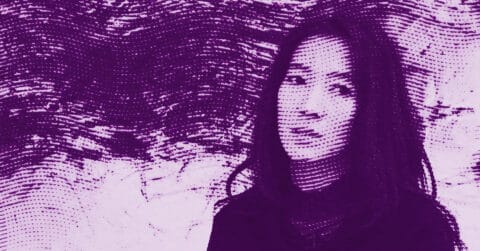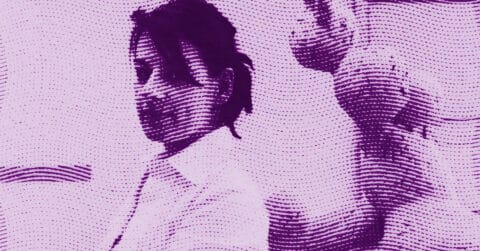Listen to me carefully, you bunch of snobs. In the crystalline building of the Cartier Foundation, a shower of gold and light transforms the space. The suspended threads of Olga de Amaral, Colombian artist born in 1932, draw aerial geometries that seem to defy gravity. This first major European retrospective, gathering nearly eighty works created between the 1960s and today, invites us to explore the monumental work of an artist who, for more than six decades, has pushed the boundaries of textile art by creating spaces of meditation and transcendence.
This groundbreaking exhibition marks a turning point in the recognition of an artist who has constantly transcended the limits of her medium. Through her creations that oscillate between tapestry, sculpture, and installation, Olga de Amaral establishes a fascinating dialogue with the existentialism of Jean-Paul Sartre, especially in his conception of creative freedom. Her work embodies this perpetual quest to overcome material constraints to reach a form of artistic transcendence.
Amaral’s monumental installations, notably the “Brumas” series (2013), create immersive environments that radically transform our perception of space. These works, composed of suspended threads dyed in vibrant colors, do not merely occupy space; they metamorphose it into a place of contemplation and sensory experience. The spectator, faced with these creations, finds herself immersed in a universe where matter becomes light and where space becomes poetry.
This transformative dimension is particularly manifested in the way the artist handles the material. The golden surfaces of her “Alquimias” transcend their primary materiality to become reflective surfaces that modulate light. Gold, traditionally a symbol of power and wealth, becomes under her hands a medium of spiritual transformation, creating works that radiate an almost mystical presence.
Amaral’s masterful use of gold goes far beyond historical or cultural references. In her “Estelas,” begun in 1996, the golden surfaces become concrete manifestations of a quest for transcendence, transforming the precious metal into a vehicle of a spiritual experience that surpasses mere materiality.
Her initial training in architecture in Bogotá is reflected in her profound understanding of space as a medium of expression. Her monumental works, such as the “Muros Tejidos,” redefine our relationship with architectural space. The viewer is not simply facing a work of art, but immersed in a total environment that engages all their senses. The series “Bosques” and “Brumas” perfectly illustrate this spatial mastery. The suspended threads create transparent volumes that change according to the viewer’s position, generating a dynamic experience of space. These installations do not simply represent space; they transform it into a field of perceptive exploration where every movement reveals new visual configurations.
Amaral’s artistic practice is articulated around a continuous exploration of the expressive possibilities of fiber. Her work with linen, cotton, horsehair, and other traditional materials demonstrates a profound understanding of the intrinsic properties of each material. She does not merely use them; she pushes them to their limits to reveal unexplored potentials.
The artist develops a unique approach to weaving that transcends traditional techniques. She braids, knots, and interlaces the threads, creating complex surfaces that redefine the possibilities of the textile medium. These surfaces are not simple arrangements of fibers but sophisticated explorations of the expressive possibilities of the material.
Amaral’s relationship with color reveals extraordinary sensitivity. As she herself says: “I live the color. I know it is an unconscious language, and I understand it.” This intuitive and deep approach to color transforms her works into true chromatic symphonies where each shade contributes to the creation of a unique atmosphere.
The influence of the Bauhaus, acquired during her studies at Cranbrook Academy, is evident in her systematic approach to form and color. However, Amaral transcends modernist principles by merging them with Colombian vernacular traditions and pre-Columbian art. This unique synthesis creates a personal artistic language that draws from diverse sources while remaining deeply original.
Colombian landscapes, particularly the high plateaus of the Andes and the tropical valleys, profoundly inform her work. Her pieces are not literal representations of these landscapes but poetic transmutations that capture their essence. The textures, colors, and shapes of her creations emerge from a deep dialogue with the natural environment.
The “Brumas” series, spectacularly presented in the exhibition, perfectly illustrates this transformative approach. The geometric patterns painted directly on the cotton threads create diaphanous volumes that transcend mere representation. These installations become abstract landscapes of light and color, inviting the viewer to a unique contemplative experience.
The exhibition also highlights the artist’s technical evolution. Her adoption of gold leaf in the 1970s, inspired by her encounter with ceramicist Lucie Rie and the Japanese kintsugi technique, marks a decisive turning point in her practice. Gold becomes not only a material but a central element of her artistic vocabulary, capable of transforming light into matter and matter into light.
The “Estelas,” presented in the exhibition, demonstrate Amaral’s mastery in creating objects that transcend their materiality. These golden steles, composed of a woven cotton structure covered with gesso and then gold leaf, create surfaces that modulate light in a complex way, generating visual effects that constantly change depending on the viewing angle and lighting.
The exhibition at the Fondation Cartier, designed by architect Lina Ghotmeh, creates a fascinating dialogue between Amaral’s works and Jean Nouvel’s architecture. The building’s transparency becomes an active element in the experience of the works, creating a subtle play between interior and exterior, between nature and culture.
On the ground floor, Amaral’s monumental works converse with the surrounding garden, creating continuity between the exhibition space and the urban landscape. This staging highlights the works’ ability to transform their environment, to create spaces for contemplation amid the urban bustle.
The lower level of the exhibition offers a more intimate experience, organized according to a spiral inspired by recurring motifs in Amaral’s work. Dramatic lighting and dark walls create an environment conducive to contemplation, allowing the works to fully reveal their spiritual dimension.
In her quest for artistic transcendence, as Sartre might have noted, Amaral transforms every material constraint into an opportunity for expression, every technical limitation into a possibility for surpassing. Her work perfectly embodies this creative tension between the materiality of the medium and the aspiration to transcendence.
This retrospective also allows an understanding of how Amaral contributed to transforming our perception of textile art. By freeing fiber from the traditional constraints of tapestry, she created a new artistic language that transcends conventional categories. Her works are neither painting, nor sculpture, nor architecture, but a unique synthesis that opens new possibilities for expression.
The exhibition highlights Amaral’s contribution to the artistic avant-garde of the 1960s, 1970s, and 1980s. Her work, alongside artists like Sheila Hicks and Magdalena Abakanowicz, played a major role in the emancipation of textile art, long marginalized due to its perception as decorative art primarily practiced by women.
Amaral’s initial training in architecture is not merely a formal influence; it represents a fundamental approach to space as a field of possibilities. Her monumental works, particularly the “Muros Tejidos,” transform architectural space by creating immersive environments that engage all the senses. These woven walls perfectly illustrate this fusion between architecture and textile. These massive works, created from wool and horsehair, are not simply wall tapestries; they become full architectural elements, transforming the spaces they occupy. Their monumental scale and imposing physical presence create unique spatial experiences that redefine our perception of the environment.
Amaral’s innovative use of materials also reflects this architectural dimension. Her work with horsehair allows her to create rigid structures that defy traditional expectations regarding textiles. These materials, traditionally associated with craftsmanship, are transformed into constructive elements that contribute to the creation of spaces.
The “Hojarascas” (Dead Leaves) series from the 1970s shows how Amaral uses the very structure of weaving to create architectural forms. The woven strips, assembled into complex volumes, create interior and exterior spaces that recall the fundamental principles of architecture, transforming textile into a medium of spatial construction.
Her architectural education also manifests in her sophisticated understanding of scale and proportions. The “Gran Muro” (Great Wall), notably the one installed in 1976 in the lobby of the Westin Peachtree Plaza in Atlanta, demonstrates her ability to work on a truly architectural scale. This six-story work represents a complete transformation of architectural space through artistic intervention.
Amaral’s more recent works, especially the “Brumas,” demonstrate an evolution of this architectural approach. These installations create more ethereal, less defined spaces that play with the perception of solidity and transparency. They represent a new stage in her spatial exploration, creating environments that transcend the physical limits of their materials.
At 92 years old, Olga de Amaral continues to push the boundaries of her art. Her recent creations demonstrate unparalleled technical mastery and a constant ability to renew her artistic language. Her work reminds us that true art often arises from the ability to transcend the limits of its medium to create new forms of expression.
This retrospective at the Fondation Cartier offers us a unique opportunity to discover the scope and depth of Olga de Amaral’s work. Through her creations that transcend traditional categories of art, she invites us to an experience that engages our whole being. Her work perfectly illustrates art’s ability to transform our perception of the world. Olga de Amaral’s oeuvre reminds us of the power of authentic artistic engagement. Her creations, which transform matter into spiritual expression and space into an experience of transcendence, invite us to rediscover our own capacity for wonder in the face of the beauty of the world.
















